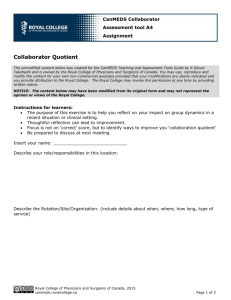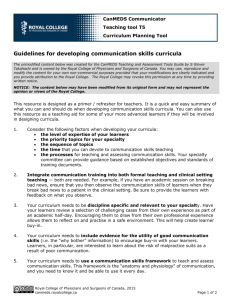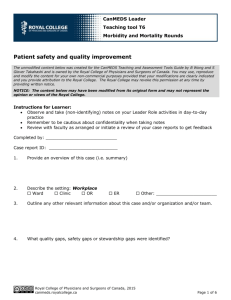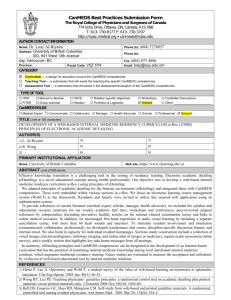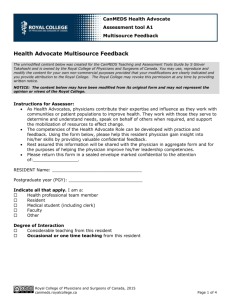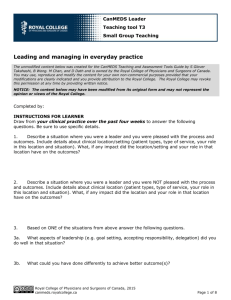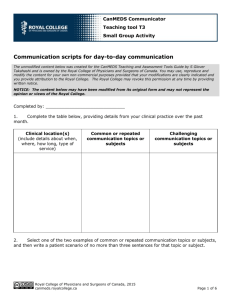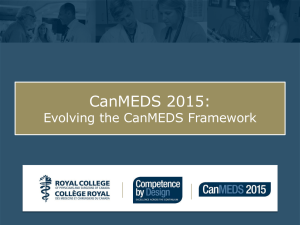MS Word
advertisement
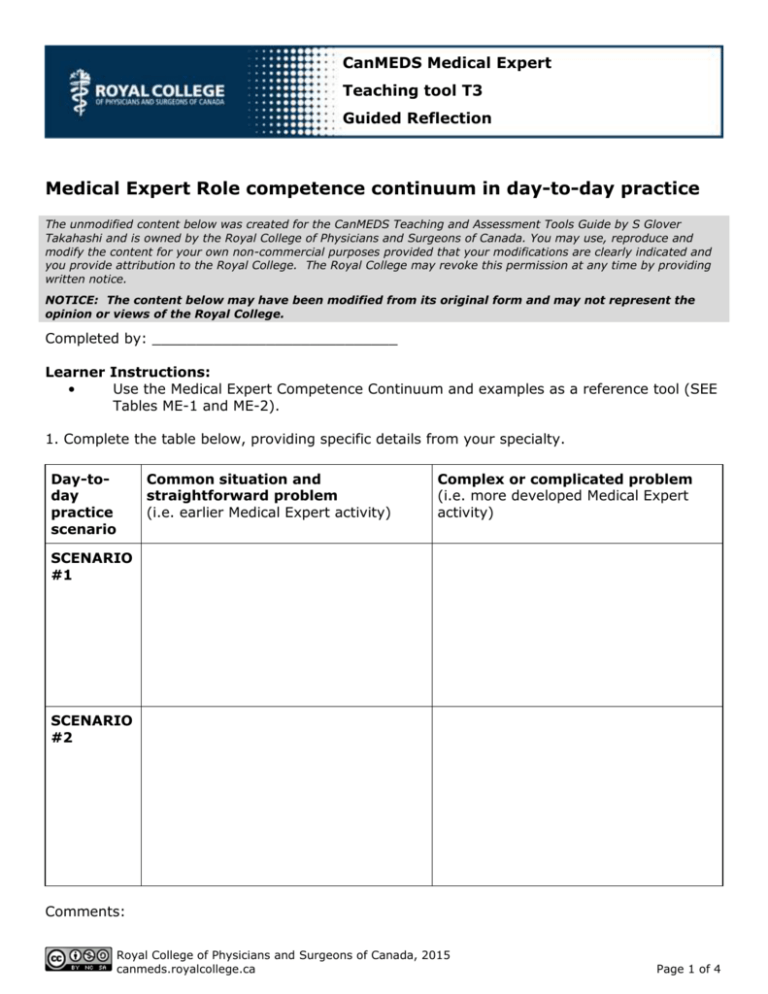
CanMEDS Medical Expert Teaching tool T3 Guided Reflection Medical Expert Role competence continuum in day-to-day practice The unmodified content below was created for the CanMEDS Teaching and Assessment Tools Guide by S Glover Takahashi and is owned by the Royal College of Physicians and Surgeons of Canada. You may use, reproduce and modify the content for your own non-commercial purposes provided that your modifications are clearly indicated and you provide attribution to the Royal College. The Royal College may revoke this permission at any time by providing written notice. NOTICE: The content below may have been modified from its original form and may not represent the opinion or views of the Royal College. Completed by: ____________________________ Learner Instructions: • Use the Medical Expert Competence Continuum and examples as a reference tool (SEE Tables ME-1 and ME-2). 1. Complete the table below, providing specific details from your specialty. Day-today practice scenario Common situation and straightforward problem (i.e. earlier Medical Expert activity) Complex or complicated problem (i.e. more developed Medical Expert activity) SCENARIO #1 SCENARIO #2 Comments: Royal College of Physicians and Surgeons of Canada, 2015 canmeds.royalcollege.ca Page 1 of 4 CanMEDS Teaching and Assessment Tools Guide Medical Expert teaching tool T3 2. For each of the scenarios you chose in question 1, identify the one or two additional CanMEDS Roles you could most easily highlight when teaching or assessing Medical Expert. Day-today practice scenario Common situation and straightforward problem (i.e. earlier Medical Expert activity) Complex or complicated problem (i.e. more developed Medical Expert activity) SCENARIO Additional CanMEDS Roles most easily #1 highlighted when teaching or assessing from the Medical Expert above Additional CanMEDS Roles most easily highlighted when teaching or assessing the Medical Expert SCENARIO Additional CanMEDS Roles most easily #2 highlighted when teaching or assessing from the Medical Expert above Additional CanMEDS Roles most easily highlighted when teaching or assessing the Medical Expert Comments: Royal College of Physicians and Surgeons of Canada, 2015 canmeds.royalcollege.ca Page 2 of 4 CanMEDS Teaching and Assessment Tools Guide Medical Expert teaching tool T3 LEARNER RESOURCES Table 1: Five stages of the learner on the Medical Expert competence continuum 1. Entry to residency Is oriented to residency and to the inventory of knowledge and skills 2. Transition to discipline 3. Foundations of discipline 4. Core of discipline 5. Transition to practice Has an awareness of and can act on key parts of highvolume routine cases, common situations, and straightforward problems Handles highvolume routine cases, common situations, and straightforward problems on their own; has an awareness of complicated situations and problems Handles with efficiency highvolume routine cases, common situations, and straightforward problems on their own; acts on complicated situations and problems with support. Prioritizes with increasing efficiency Handles complex and complicated situations and problems on their own, and guides or supports others. Manages with various concurrent priorities. Develops judgment/wisdo m to decide between various courses of action EARLIER -------------------------------------------------------------------------------------- END in Residency of Residency Royal College of Physicians and Surgeons of Canada, 2015 canmeds.royalcollege.ca Page 3 of 4 CanMEDS Teaching and Assessment Tools Guide Medical Expert teaching tool T3 Table 2: Examples of Medical Expert activities at two points on the competence continuum SAMPLE day-to-day scenario Common situation and Complex or complicated problem straightforward problem (i.e. more developed Medical (i.e. earlier Medical Expert activity) Expert activity) Case report from learner to faculty Learner gives a top-line summary of the patient history, inventory of problems, and planned treatment in a standard format to a faculty member who is a supportive teacher. The blood work report that the learner requires to prepare an accurate treatment plan was delayed in being posted, and the learner, busy managing other patient priorities, did not discover this in sufficient time before case rounds to be able to hunt down the results with a phone call. Rounds Learner participates in teaching rounds with own team and on a topic with which the learner is quite familiar. Learner presents a balanced overview of the literature and makes recommendations based on current best practice. Phone consultation Learner holds a conversation with the referring primary care physician about needed community follow-up. Learner calls the referring specialist in another community to report that the requested intervention is not available for the patient (e.g. because patients from that region are not eligible owing to limited resources/funding). The learner then problem-solves with the referring specialist about alternatives to the requested intervention. Goals of care Learner meets with a patient and one family member before surgery to discuss elective surgical options. Learner holds a post-operative meeting with a patient and three family members, all of whom have a limited comprehension of English and French, to review a serious pathology report and plan for identified further treatment with the assistance of a translator. EARLIER ------------------------------------------------------------------------------------ END in Residency of Residency Royal College of Physicians and Surgeons of Canada, 2015 canmeds.royalcollege.ca Page 4 of 4
